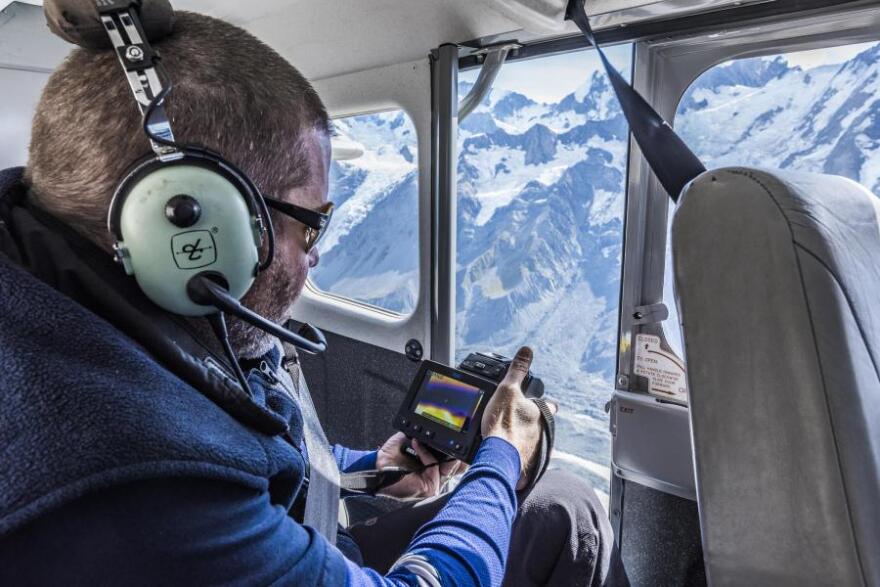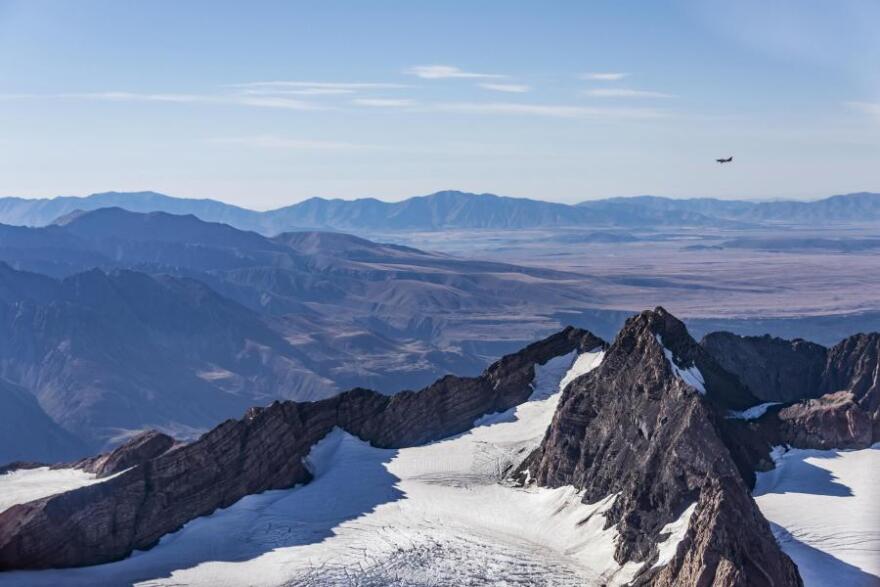Note: WXPR’s Ben Meyer celebrated his honeymoon in New Zealand this month with his wife, Erika. This week’s edition of The Stream is inspired by their visit to one of New Zealand’s mountain glaciers.
Every day the weather cooperates, a helicopter delivers hikers onto Fox Glacier in the mountains of New Zealand’s South Island.
Guides lead groups wearing boots and crampons across the ice sheet, which sparkles white on the surface and bright blue in its many crevasses and ice arches.

A hike on the glacier was a top destination for my wife Erika and me during our New Zealand honeymoon this month.
But this glacier is melting and disappearing, as seen in this time-lapse, like thousands of glaciers across the globe, a direct result of human-caused climate change.

A few years ago, helicopters like the one Erika and I took to Fox Glacier became the only way to access it.
“We used to walk on. All the trips used to walk on. But what’s happened [is] the glacier is receding back into two rockfall zones, and the rocks are just falling

and it’s just not safe anymore,” said Iain May, our glacier guide.
May pointed to a waterfall on the valley wall dozens of feet above the glacier’s current surface to show how much the glacier has disappeared.
“The lower part of the waterfall that we can just see the top of – roughly in 1998, the ice at the bottom was just sitting below the top of there,” May said. “You can really see how much melting has happened in that area.”
The visual representation of the ice loss is stunning.

Dr. Heather Purdie studies losses like this, but years ago, Purdie was in May’s shoes, hiking Fox Glacier with visitors.
“Before I became an academic, I actually used to work as a glacier guide on Fox Glacier, so I am very attached to it,” she said.

Now, Purdie is a glaciologist and senior lecturer at the University of Canterbury in Christchurch, New Zealand. Her research provides precise measurements on Fox Glacier’s movement, size, and volume.
“The glacier is shorter than we’ve ever recorded it before,” Purdie said. “It’s 12.1 kilometers long, so it’s the shortest we’ve ever seen it.”
Purdie suspects it’s also thinner than ever and getting smaller.
In a way, the receding glacier mirrors a process that happened much closer to home more than 10,000 years ago.
This week, research scientist Dr. Carl Watras took me to Crystal Lake in northern Wisconsin’s Vilas County, an example of a glacial kettle lake.

“Kettle lakes formed as the glacier retreated about 10,000 years ago,” Watras explained. “As the glacier moved back north, it shrunk. There was a lot of sand deposited, and glacial till. In that sandbox, as it were, big chunks of ice broke off. Crystal Lake here is one of the classic examples [in which] a large chunk of ice in a large sandbox melted and formed this lake.”
Our region is dotted with kettle lakes, formed when the last glacier retreated from Wisconsin and left those ice chunks in glacial till. The phenomenon is like ice cubes being buried in a sandbox, then melting.

The lakes are easy to spot.
“No inlet and no outlet. A fairly regular geometric shape. They tend to quite circular,” Watras said.

Elmo Rawling, a geologist at the Wisconsin Geological and Natural History Survey (WGNHS), said the last ice age left behind a distinctive landscape in Vilas and Oneida counties.
“It is among the densest concentration of lakes in the world,” Rawling said. “There are lots of other places with dense concentrations of lakes, but the Northern Highlands has an enormous amount of lakes.”
That ice age featured continental-size glaciers, while New Zealand’s glaciers only occupy mountain valleys.
But there’s another big difference.
Humans played little role in the retreat of North American glaciers 10,000 years ago.

Now, human contributions to climate change are among the biggest factors in ice loss worldwide.
Dr. Drew Lorrey, a principal scientist at New Zealand’s National Institute of Water and Atmosphere Research, works to document the change. Next month, he’ll take his annual flights over more than 50

glaciers in the country, taking precision photographs.
Lorrey said good years for glaciers are getting rare.
“The last few summers have been really bad,” Lorrey said. “I would go as far as to say catastrophic for our glaciers.”
He repeated a phrase I heard a lot among New Zealand glaciologists.
“Glaciers don’t lie,” he said.

That is, the living ice sheets can’t hide the truth about climate change.
“You cannot manipulate what is happening with that snow and ice and the attribution of what is happening here is really undeniable,” Lorrey said.
“These glaciers get a lot of snow, but it’s still not enough to counteract the warming that’s happening right around the globe. The glaciers record that because they can’t lie,” Purdie agreed. “If it’s warming up, they’re going to melt, and there’s nothing they can do about it.”
People like Erika and me can still take helicopter hikes onto glaciers with guides.

But if the glaciers disappear, a tourism loss for visitors would also mean a cultural loss for New Zealanders.
“For our country, I think there is this real amazing cultural and spiritual connection to the alpine region and to our glaciers,” Lorrey said. “They represent a really majestic part of our landscape.”
As we helicoptered off the melting Fox Glacier, Erika and I wondered whether it would be the last glacier we ever experienced in person.
For researchers like Heather Purdie, New Zealand’s disappearing glaciers are even more than an economic and cultural loss.
The trend hits on a personal, emotional level.
“It does feel a bit sad that you’ve just got this thing that you’ve been working on for years that is shrinking away before your eyes,” she said.








